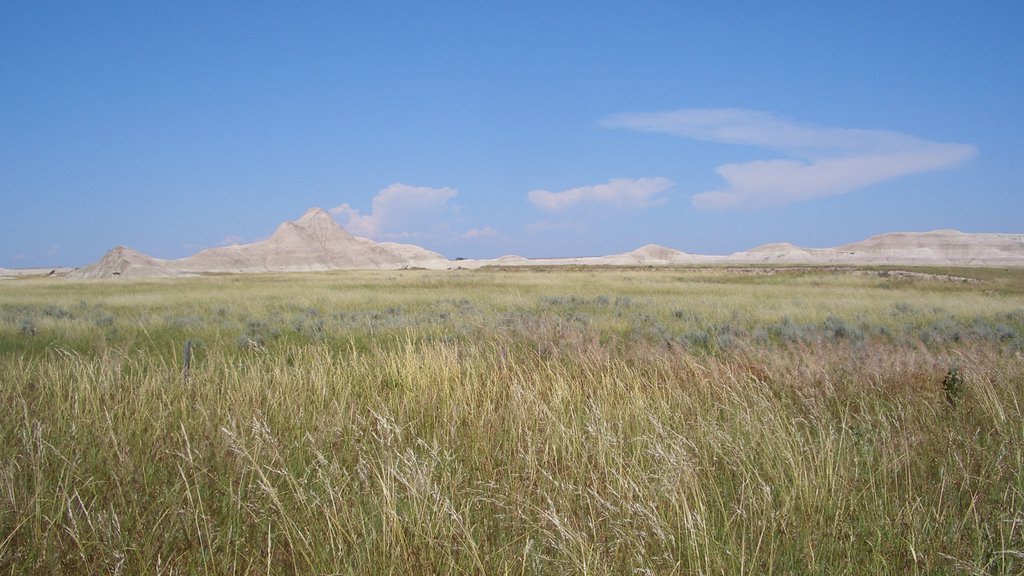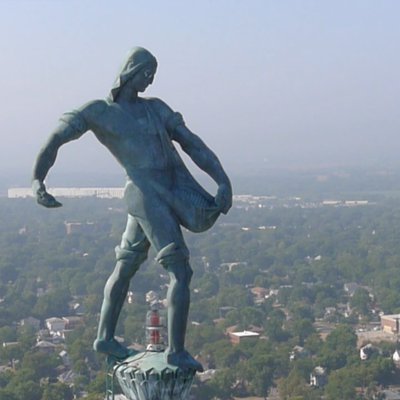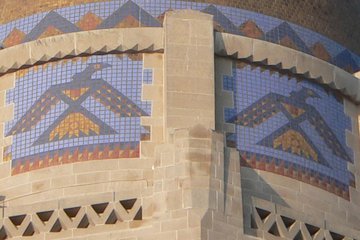CH 1
Overall Building
The Tower and the Plains
Lesson 1 - Sowing the Seeds
The SowerA person who plants seeds. was designed by the same artist who designed all the sculpture you see on the walls of this building-- Lee Lawrie. Lawrie was a self-taught sculptor who specialized in architectural decorationElements of a building’s design that add special meaning and beauty—reliefs, engaged sculptures, trim, tiles, and so on..
Of course, the sculptures Lee Lawrie created for the Nebraska Capitol are meant to be more than decoration. All of them are carefully chosen symbolsA symbol is something that stands for or represents something else. that tell Nebraska’s story. The sower—is the biggest thing on the building. He's a farmer who is literally on top of everything. That tells you something about the importance of agriculture here in Nebraska.

The Sower isn't dressed like the farmers you've seen-- he's idealizedPortrayed as perfect, ideal.. He's here planting seeds to remind you of how humans get life from the soil.
Does Nebraska look like a desert to you?

Nebraska looked like a desert to the explorers who came here from the eastern part of America in the early 1800's. As they floated on the Missouri River in 1803, Lewis and Clark thought the land they saw along the shore had no value.
After a trip along the Republican River in 1806, Lieutenant Zebulon Pike called the soil barrenIn this case, barren means not good for growing crops.. In 1820, Stephen H. Long of the Army Engineers wrote that the area between the Missouri River and the Rocky Mountains was "unfit for cultivationSpecial care that helps a particular plant or crop to grow, including plowing, fertilizing, and so on.."
He said people who depended on agriculture to live simply couldn't live there.
What is now Nebraska was considered part of the Great American Desert, treeless and practically useless. The public in the east was unaware of the rich soils waiting under the prairie grass.

Nebraska has several important rivers that flow into the Missouri River, including the Platte. It also has a vast underground water supply, part of the Ogallala Aquifer. The aquifer contains enough to cover the surface of the state with water 34 feet deep. But the Americans of the early 1800's knew nothing about it. (Reset image)
[INSERT VIDEO FILE}
Of course, Native Americans had long lived on Nebraska's land, some by farming and some by hunting the buffalo herds.
The government of the United States first thought Nebraska would be left to the Native Americans and the bison. But then Nebraska's value changed as plans developed for the transcontinental railroadA railroad that goes all the way across the continental United States, from the east coast to the west coast.. The government opened the land to would-be farmers through the Homestead ActUnder the Homestead Act of 1862, the government sold land in the western territories to new settlers at low cost..
By the time Nebraska achieved statehood in 1867, settlers west of the Missouri River had learned that they could grow crops even in places where trees didn't grow, and homesteaders were starting to take their chances on farming west of the Missouri. They proved Nebraska was no desert.

The state does have sandy areas – actual hills of sand. But much of the state is more fertileGood for growing crops.. Land is one of Nebraska's richest resources, in part because there's so much of it.
The type of land affected the way people who settled there used the land-- and the way they lived. In the fertile areas, farming made sense. In the areas by water or close to transportation routes, towns and cities grew up. In the less fertile areas, where grasses grow, raising cattle was a way to make a living.

Nebraska has abundant grass.
Tall prairie grasses grow in the east; short grasses grow in the west.

Trees were once scarce in Nebraska, but plantings from settlers changed that. Now ash, box elder, cottonwood, locust, oak, walnut, elm, and willow trees are common in the east, while pine and cedar are found in the west.
You find shrubs such as wild plums and chokecherries growing wild all over Nebraska. There are wild flowers, too, like goldenrod, sunflowers, columbine, larkspur, and wild roses. (Reset Link)
With cultivation and enough moisture, Nebraska's variety of soils can produce a variety of crops. In fact, Nebraska has often led the nation in production of some crops. The state’s crops feed people and animals, and they also feed the economy through sales of products related to agriculture, such as irrigation equipment.
The top crop is corn, used as feed by cattle, hog, and poultry producers. Corn has been growing in Nebraska since the first Native American farmers settled here. Now it's also used in ethanol, a fuel additive.
Show What You Know!
What is in Nebraska?
Did these resources exist in Nebraska before the settlers came? Choose Yes or No.
You got correct!
SOMETHING TO THINK ABOUT . . .
Early visitors were mistaken about Nebraska’s ability to grow crops.
Why was their “first impression” wrong?
Do you ever rely on first impressions?
Why is that a good or bad idea?










